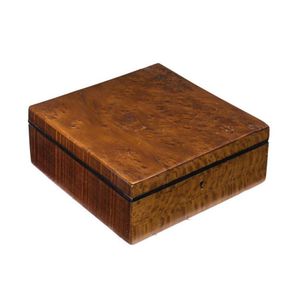Australian Cedar Writing Box, 1860
You must be a subscriber, and be logged in to view price and dealer details.
Subscribe Now to view actual auction price for this item
When you subscribe, you have the option of setting the currency in which to display prices to $Au, $US, $NZ or Stg.
- Fiddleback - A name given to the pattern of the grain in some timbers, where the lines of the grain are compressed and at the same time wavy. Fiddleback grain is prized as a timber for furniture and musical instruments, and is expensive becasue of its scarcity.
In Australia fiddleback graining is found in blackwood. Other non-native timbers that are sometimes found with a fiddleback grain are mahogany and maple. - Circa - A Latin term meaning 'about', often used in the antique trade to give an approximate date for the piece, usually considered to be five years on either side of the circa year. Thus, circa 1900 means the piece was made about 1900, probably between 1895 and 1905. The expression is sometimes abbreviated to c.1900.
- Oak - Native to Europe and England, oak has been used for joinery, furniture and building since the beginning of the medieval civilisation. It is a pale yellow in colour when freshly cut and darkens with age to a mid brown colour.
Oak as a furniture timber was superceded by walnut in the 17th century, and in the 18th century by mahogany,
Semi-fossilised bog oak is black in colour, and is found in peat bogs where the trees have fallen and been preserved from decay by the bog. It is used for jewellery and small carved trinkets.
Pollard oak is taken from an oak that has been regularly pollarded, that is the upper branches have been removed at the top of the trunk, result that new branches would appear, and over time the top would become ball-like. . When harvested and sawn, the timber displays a continuous surface of knotty circles. The timber was scarce and expensive and was used in more expensive pieces of furniture in the Regency and Victorian periods. - Blackwood - One of the best known and most widely used Australian timbers, blackwood (acacia melanoxylon), is a member of the Acacia (wattle) family and grows in eastern Australia from about Adelaide in South Australia, as far north as Cairns in Queensland.
The largest, straightest and tallest trees come from the wet forest and swamps of north-west Tasmania where it is grown commercially.
Blackwood timber colours range across a wide spectrum, from a very pale honey colour through to a dark chocolate with streaks of red tinge.
The hardwood timber has been commonly used in the production of furniture, flooring, and musical instruments in Australia from the late 19th century. However, the straight grain timber is not the most prized or valuable, that honour falls to blackwood with a wavy, fiddleback pattern, which is used both in the solid and as a veneer. Fiddleback was only used on the finest examples of furniture. - Casuarina - Casuarina, is also known as beefwood (because of its appearance) she-oak, swamp oak, river oak, forest oak and Botany Bay wood. It is a native Australian hardwood, red brown in colour with dark flecks.
This item has been included into following indexes:
- boxes, material or decoration
- boxes, writing
Visually similar items

A Tasmanian timber jewel box, huon pine, fiddleback blackwood, beefwood, she oak and burr totara (New Zealand), circa 1900, with accompanying letter and Albert fob chain, high, 18 cm wide, 18 cm deep

Vintage fiddle-back grain cigar box, 18 cm wide approx

A Victorian walnut writing box inlaid with brass and mother of pearl, with original inkwells, interior restored. 14 cm high, 35 cm wide, 24 cm deep

1948 Australian Tour to England: Silver presentation cigarette box, engraved on lid 'Presented To Mr R.A.Hamence, A Member of the 1948 Australian Team, by the Australian Board of Control for International Cricket. To Commemorate the Team's Achievement in n
